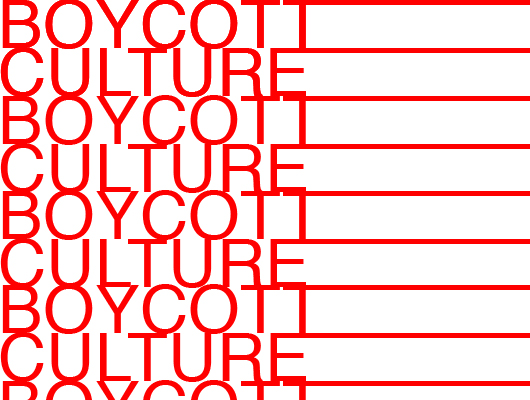When positions are deeply entrenched, political passions inflamed and a reasoned debate almost impossible, art can bring people together by encouraging empathy and developing a deeper understanding, it can offer a place where the black and white of conflict is replaced by the complex tapestry of national histories and the singular weavings of individual lives.
But that ability of art is severely challenged today – especially when it comes to one of the defining conflicts of our times. Any art institution that displays art about the Israeli/Palestinian conflict – or even art that is created by Israeli or Palestinian artists – needs to carefully navigate a space between intense pressures coming from right-wing pro-Israel groups and calls for boycott from supporters of the cultural BDS (Boycott, Divestment and Sanctions) movement.
Right-wing activists regularly paint individuals and institutions who are critical of Israeli government policies as anti-Israel or even anti-Semitic in an effort to silence them. Many of these efforts are successful. In October 2017, after accusations of supporting “anti-Israel” programming, the American Jewish Historical Society in New York cancelled a reading of Rubble Rubble, a play by Dan Fishback. In 2016, similar pressures led to the cancellation of Julia Pascal’s Crossing Jerusalem at the North Beach Miami Jewish Community Center, a play set during the 2002 Intifada that explores Jewish-Palestinian relations. Previous controversies and cancellations included a Metropolitan Opera production of John Adams’ The Death of Klinghoffer, the New York Theater Workshop’s My Name is Rachel Corrie, the Spertus Institute’s exhibition Imaginary Coordinates among others.
At the same time, on the other side of the political spectrum, the cultural BDS movement threatens to boycott any institution that hosts work which is supported by Israeli government funds.
Boycotts – both cultural and economic – are, of course, a constitutionally protected and powerful way not only to express an opinion, but to put economic power behind it. Economic boycotts were very effective in achieving political and social change during the battles against apartheid in South Africa and segregation in the United States. Indeed, when human rights are violated and no international body has the power (or will) to stop the abuse, when criticism is disregarded and world leaders are more interested in geopolitical dominance that preserving rights, what recourse remains?
Cultural boycotts, however, offer uncertain gains and come at a high cost. Inevitably, they restrict the circulation of ideas by discouraging performances, films or exhibitions that have received Israeli state support. They pressure cultural producers not to work with Israeli institutions and urge artists not to exhibit in Israel. Cultural boycotts may not be not intended as censorship, but this is their effect. Even institutions that are not directly targeted often self-censor to avoid controversy. As a result, cultural boycotts can be counterproductive by eliminating opportunities for better understanding of the Middle East, opportunities which could, in the long run, contribute to resolving the current impasse.
Take the case of the 2017 Lincoln Center presentation of David Grossman’s To the End of the Land, a play which explores the entanglement between private lives, war and history in Israel between 1967 and 2000. In his 2010 review of the novel, upon which the play is based, Colm Tóibín wrote: “To say this is an antiwar book is to put it too mildly… This is one of those few novels that feel as though they have made a difference to the world.” The author, Grossman, is an outspoken critic of the Israeli government and its cultural policies, as well as a prominent peace activist.
Nevertheless, a large group of prominent New York cultural figures – playwrights, filmmakers, actors and directors, including Caryl Churchill, Wallace Shawn, Lynn Nottage and Taylor Mac – demanded that Lincoln Center cancel To the End of the Land because the production received Israeli government funding. Cancelling performances would have deprived audiences of an important critical voice coming from within Israel, as well as of the opportunity to deepen their understanding of the human side of a tragic socio-political conflict.
The need for artists and art institutions to accept funding from sources – governmental or private – that are rarely pure or saintly, poses problems everywhere. Political and religious pressures exacerbate that problem for cultural producers in the Middle East. To make her first film, the story of three young Arab women living together in Tel Aviv, Maysaloun Hamoud, an Israeli-Palestinian filmmaker had to take Israeli government funds because Palestinian funding for films is practically nonexistent – and, even if it were, would not have been granted to the film, whose content made Hamoud the target of the first fatwa to be issued in Palestine since 1948.
To be a cultural producer in the Middle East is not easy, but we urgently need art – both art coming from the area and international art going there – to help us make our way through and beyond the entanglement of politics, to build understanding and alliances, to see the world outside current tribal bubbles and received modes of perception. Art makes it possible for individuals to be seen in all their complexity, beyond the stereotypes and prejudice.
The cultural BDS movement is a double-edged sword that needs critical examination. Are the uncertain gains of cultural boycotts worth limiting the circulation of voices and ideas and alienating potential allies? Could the energy spent in cultural BDS campaigns be better directed towards working to ensure mobility and funding of more Palestinian – as well as Israeli – artists and collectives?
We need to hear more of the diverse voices in the Middle East in order to understand the felt reality of people in the region, to open up a conversation between politically opposed parties, to, perhaps, even dare to imagine a common ground. That will only happen if we strongly oppose any effort to suppress artist voices and all attempts to intimidate cultural institutions.
A version of this article was originally published by the Dramatists Guild of America.


